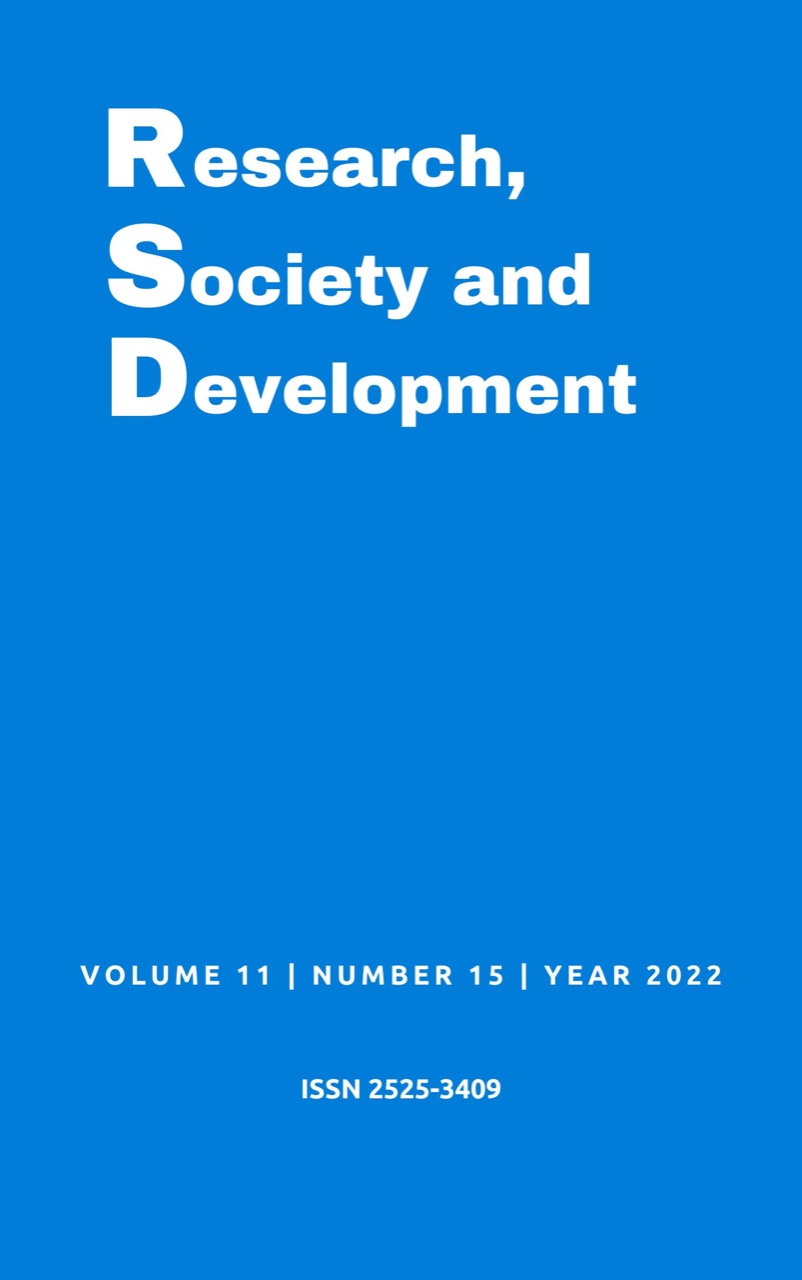The psychosocial environment in the Legislative Houses of Brazil from the perspective of public workers with absenteeism-illness
DOI:
https://doi.org/10.33448/rsd-v11i15.36693Keywords:
Psychosocial Risks, PROART, Public Workers, Psychosocial risk assessment.Abstract
This study is part of a larger investigation concerning the sickness absenteeism of legislative workers in Brazil. The article aimed to evaluate and characterize the psychosocial risk factors, which will be used in absenteeism investigation. 400 workers from three Legislative Houses were recruited to fill an online protocol for assessing psychosocial risk factors at work (PROART). From ten factors that comprise the four scales of PROART, only the mental exhaustion factor (ME) was recognized as a medium-level risk by the workers. This condition represents a state of alert or critical situation of the psychosocial factors that requires interventions in short and mid-term. The multiple linear regression model for psychological damage (SD) presented the most expressive value (R²=0.587, p-value<0.05), indicating that the lack of meaning at work (FST), ME and the lack of recognition (FR) were able to explain 58.7% of the SD variability. The psychosocial environment, in general, showed moderate levels of workplace tension, however, it was evidenced critical points with significant potential to threaten the mental and physical health of public workers.
References
Álvarez Briceño, P. (2009). Los riesgos psicosociales y su reconocimiento como enfermedad ocupacional: consecuencias legales y económicas. Telos, 11(3), 367–385. http://ojs.urbe.edu/index.php/telos/article/view/1781
Araujo, L. K. R. (2017). Protocolo de avaliação dos riscos psicossociais: adequação ao SAMU-DF [Fundação Oswaldo Cruz]. https://www.arca.fiocruz.br/handle/icict/24062
Areosa, J. (2019). O mundo do trabalho em (re)análise: um olhar a partir da psicodinâmica do trabalho. Laboreal, 15(2), 0–24. https://doi.org/10.4000/laboreal.15504
Loi relative au bien-être des travailleurs lors de l’exécution de leur travail, 1 (2021). http://www.ejustice.just.fgov.be/eli/loi/1996/08/04/1996012650/justel
Carlisle, K. N., & Parker, A. W. (2014). Psychological distress and pain reporting in Australian coal miners. Safety and Health at Work, 5(4), 203–209. https://doi.org/10.1016/j.shaw.2014.07.005
Dejours, C. (1993). Travel, usure, mentale: Addendum - Da psicopatologia à psicodinâmica do trabalho (N. edicão, pp. 47–104).
Díaz, J. M. C. (2018). Técnicas de Prevención de Riesgos Laborales (11a). Tebar Flores.
EU-OSHA. (2020). https://osha.europa.eu/pt/. O que são riscos psicossociais e stresse? https://osha.europa.eu/pt/themes/psychosocial-risks-and-stress
Facas, E. P. (2013). Protocolo de Avaliação dos Riscos Psicossociais no Trabalho - Contribuições da Psicodinâmica do Trabalho [Universidade de Brasília]. https://repositorio.unb.br/handle/10482/15420
Facas, E. P. (2021). PROART - Riscos Psicossociais Relacionados ao Trabalho (M. Alves, C. Kummecke, & E. Munch (eds.)). Fi. https://doi.org/10.22350/9786559173686
Facas, E. P., & Mendes, A. M. (2018). Estrutura Fatorial do Protocolo de Avaliação dos Riscos Psicossociais no Trabalho. Núcleo de Trabalho, Psicanálise e Crítica Social. http://nucleotrabalho.com.br/?page_id=20
Ferreira, T. M., & Ghizoni, L. D. (2018). Mapeamento Dos Riscos Psicossociais Relacionados Ao Trabalho De Servidores Públicos Do Estado Do Tocantins. DESAFIOS - Revista Interdisciplinar da Universidade Federal do Tocantins, 5(Especial), 3–19. https://doi.org/10.20873/uft.2359-3652.2018v5nespecialp3
Guimarães, L. A. M. (2013). Fatores Psicossociais de Risco no Trabalho. Em Saúde Mental no Trabalho - Coletânea do Fórum de Saúde e Segurança no Trabalho do Estado de Goiás (pp. 274–278). Cir Gráfica. http://www.prt18.mpt.mp.br/informe-se/artigos
Health and Safety, & Executive. (2020). https://www.hse.gov.uk/index.htm. https://www.hse.gov.uk/simple-health-safety/risk/index.htm
ILO. (2013). Training Package on Workplace Risk Assessment and Management for Small and Medium-Sized Enterprises (1a). International Labour Organization - ILO. https://www.ilo.org/global/topics/safety-and-health-at-work/resources-library/training/WCMS_215344/lang--en/index.htm
International Labour Office. (2016). Psychosocial risks, stress and violence. Psychosocial risks, stress and violence in the world of work, 8(1–2), 1–127.
IPEA - Instituto de Pesquisa Econômica Aplicada. (2021). Vínculos de Trabalho no Setor Público. https://www.ipea.gov.br/atlasestado/
Kahere, M., & Ginindza, T. (2022). The prevalence and psychosocial risk factors of chronic low back pain in KwaZulu-Natal. African Journal of Primary Health Care and Family Medicine, 14(1), 1–8. https://doi.org/10.4102/phcfm.v14i1.3134
Knust, S. R. A. (2017). Sofrimento no trabalho: estudo de caso de riscos psicossociais em um órgão do Poder Legislativo Federal. http://repositorio.unb.br/handle/10482/24529
Marôco, J. (2011). Análise Estatística com o SPSS Statistics (5a). Report Number.
Moreno Jiménez, B. (2011). Factores y riesgos laborales psicosociales: conceptualización, história y câmbios actuales. Medicina y Seguridad del Trabajo, 57, 4–19. https://doi.org/10.4321/s0465-546x2011000500002
Neto, H. V. (2015). Estratégias organizacionais e intervenção sobre riscos. International Journal on Working Conditions, 9, 2–21. http://ricot.com.pt/artigos/1/IJWC.9_HVN.p.1-21.pdf
OIT - Organização Internacional do Trabalho. (2010). Riscos emergentes e novas formas de prevenção num mundo de trabalho em mudança (pp. 1–20). http://www.ilo.org/lisbon
OSHA. (2020). Orientação para determinação de perigos. https://www.osha.gov/dsg/hazcom/ghd053107.html#a
Pires, C. (2018). As influências das práticas de gestão nas vivências de sofrimento no trabalho dos subordinados em um órgão do Poder Judiciário com atuação em Goiás [Universidade Federal de Goiás, Faculdade de Educação]. https://repositorio.bc.ufg.br/tede/handle/tede/8375
Portrait, A. S. (2018). The European economy since the start of the millennium.
Potter, R., O’Keeffe, V., Leka, S., Webber, M., & Dollard, M. (2019). Analytical review of the Australian policy context for work-related psychological health and psychosocial risks. Safety Science, 111(September 2018), 37–48. https://doi.org/10.1016/j.ssci.2018.09.012
Santi, D., Barbieri, A. R., & Cheade, M. de F. (2018). Absenteísmo-doença no serviço público brasileiro: uma revisão integrativa da literatura. 16(1), 71–81. https://doi.org/10.5327/Z1679443520180084
Downloads
Published
Issue
Section
License
Copyright (c) 2022 Francisco Edison Sampaio; Manuel Joaquim Silva Oliveira; João Areosa; Emílio Facas

This work is licensed under a Creative Commons Attribution 4.0 International License.
Authors who publish with this journal agree to the following terms:
1) Authors retain copyright and grant the journal right of first publication with the work simultaneously licensed under a Creative Commons Attribution License that allows others to share the work with an acknowledgement of the work's authorship and initial publication in this journal.
2) Authors are able to enter into separate, additional contractual arrangements for the non-exclusive distribution of the journal's published version of the work (e.g., post it to an institutional repository or publish it in a book), with an acknowledgement of its initial publication in this journal.
3) Authors are permitted and encouraged to post their work online (e.g., in institutional repositories or on their website) prior to and during the submission process, as it can lead to productive exchanges, as well as earlier and greater citation of published work.


